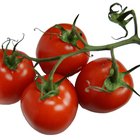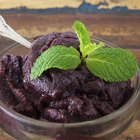
Christopher Stokey/iStock/Getty Images
According to the National Cancer Institute, one out of every six American men develops prostate cancer in his lifetime. In 1995, a study by Dr. Edward Giovannucci and colleagues at Harvard University found that men who consumed tomatoes or tomato products developed fewer cases of prostate cancer. Since then, researchers have sought to identify the component in tomatoes that provides this and other benefits.
Tomato Nutrients
Tomatoes contain significant amounts of vitamin E, fiber, antioxidant polyphenols, potassium and folate. Most tomato and prostate cancer research focuses on lycopene, the red pigment of tomatoes. The lycopene content of tomato products varies widely depending upon variety, ripeness of the fruit and processing methods, making it difficult to make dietary recommendations.
Lycopene in Foods
According to Harvard Medical School, one slice of raw tomato contains approximately 515 micrograms lycopene, while 2 tablespoons of tomato paste contains 13,800 micrograms of lycopene. That means tomato paste contains many times more lycopene than raw tomatoes. Because most research attributes the anticancer properties of tomatoes to lycopene, tomato paste appears to be the better source.
Lycopene Concentration
The higher water content of raw tomatoes reduces total lycopene concentration. Raw tomatoes contain approximately 94.5 percent water by weight, according to the USDA Nutrient Database. The processing of tomatoes to form tomato paste causes water loss, so lycopene becomes more concentrated.
Lycopene Structure
The structure of lycopene determines how much the body absorbs. Two primary forms of lycopene exist: a straight line -- the all-trans form -- and a chain with kinks -- the cis-isomer form. Processing of tomatoes to form tomato paste increases the amount of cis-lycopene. The smaller structure of the cis-lycopene isomer allows for easier absorption in the small intestine compared to all-trans lycopene. This means that when you eat tomato paste, more of the kinked form of lycopene accumulates in the body compared to its straight counterpart.
Related Articles

Fresh Tomatoes vs. Canned

How to Get Rid of Blackheads With ...

How do I Make Chili With Roma Tomatoes?

Calories in Cheese Cubes

Calories in Pasta Fagioli Soup

Are Bean Sprouts Good for You?

What Foods Provide Calcium D-Glucarate?

Best Fruit Juices to Cleanse the Colon

Nutrition Information on Blueberries

Active Ingredients in Mederma

Characteristics of Polyester & Cotton

The Genesis Diet
How to Cook & Freeze Fresh San Marzano ...

How to Make Tomato Bruschetta

Types of Cotton Fabric

Fruits & Vegetables Rich in Potassium ...

Aloe Ferox Benefits

List of Retinoids

Acai Berry & Acne

Denim vs. Denim Blends
References
Writer Bio
Nikki Ford first published in 2003 and has published in periodicals such as the "Journal of Nutrition" and "Nutrition and Cancer." Ford earned her Doctor of Philosophy in nutritional sciences (diet and cancer emphasis) from the University of Illinois and is currently a post-doc at the University of Texas at Austin.
Photo Credits
Christopher Stokey/iStock/Getty Images